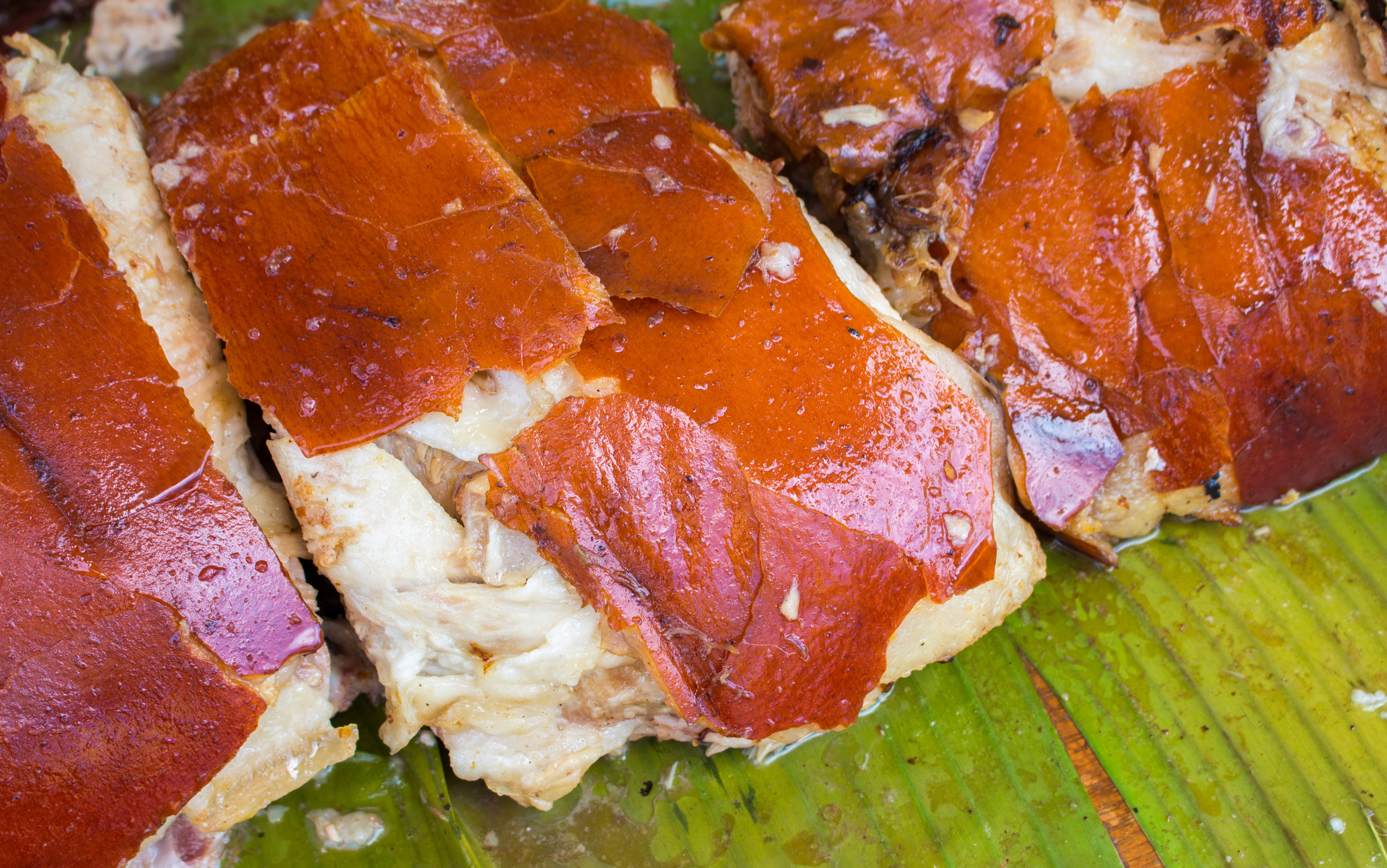Lechon Is The World's Most Delicious Christmas Tradition
One of the most convincing arguments that Filipinos have mastered the roast pig, or lechon, is its skin: brick red and so immensely crunchy it crackles between your teeth like you were chewing glass. Other cultures are known for their own versions of roast pig—the Cantonese suckling pig siu yuk, and whole hog barbecue in the Carolinas come to mind—but Filipinos have managed to raise the standard so high that in 2009, no less a worldly traveler than Anthony Bourdain proclaimed lechon the "best pig ever."
It's high praise for something where preparation and cooking is a straightforward, albeit time-consuming process. Pigs are butchered, their hair singed or scalded off, and their bellies slit open and stuffed with a bouquet of herbs and seasonings like leeks, garlic, salt, and lemongrass. The skin is often rubbed with coconut water, soy sauce, or milk before the pig is roasted on a spit over coals for up to five hours.
Once the lechon is ready to eat, the skin is scored and usually served with a portion of the meat, although it's best to eat the skin separately. The tastiest parts of lechon are arguably the ribs and the belly, where fat is plentiful and the flavor more concentrated.
Although lechon isn't the only national dish in the Philippines, it may be the most celebrated—especially around Christmastime. Throughout the year, various lechon festivals are held in cities and towns throughout the archipelago, with competitors entering with punny names like Pigtoria's Secret and Manny Porkquiao. Multiple lechon restaurants and businesses also proliferate, with some so famous that their lechons are flown across the country for weddings and christenings. Each region in the Philippines has its own style and flavor of lechon, but the reigning champion is arguably the southern Philippine city of Cebu (where Bourdain tasted sampled his sample).
Cebu has built a reputation for the variety and high quality of its lechon, which has lately become a standard for the entire nation. Anton Diaz, who has covered different lechon purveyors in his food and travel blog Our Awesome Planet, explains that traditional Cebu lechon's popularity is due to how flavorful the meat is on its own without the addition of sauce (noting as well that the lechon that Bourdain was served, from Zubuchon, isn't considered traditional Cebu lechon, as it uses herbs like rosemary for its stuffing that aren't commonly found in traditional recipes).
Although Cebu may be a strong contender for lechon capital of the Philippines, the historic capital has long been the La Loma district in Metro Manila, where the lechon business was almost singlehandedly jumpstarted by Tomas De Los Reyes, more commonly known as Mang ("Mister") Tomas. In the 1950s, Mang Tomas sold pork meat outside his house, which was located near the then-popular La Loma Cockpit Arena. Eventually, Mang Tomas began cooking lechon for the celebrating cockfight winners—owners of fallen chickens ate the losers instead—and soon, the flavor of his roast pig began to draw more than just cockfight attendees.
The popularity of Mang Tomas's lechon and his sweet, savory pig liver-based gravy led to a boom in lechon businesses in La Loma. Mang Tomas' business still continues to ply its trade there, although his gravy is now available in bottled form (minus the liver) and sold around the world. It's that gravy—or a close approximation—that many lechon eaters have grown up with, and the sauce has covered up the blandness and chewiness of many an inferior lechon. It's also used to make a quick version of lechon paksiw, a garlicky stew made of leftover lechon that is fantastic with rice.

That said, lechon connoisseurs and lechoneros agree that the best lechon needs no sauce at all. Pops Bacatan, head of sales and marketing at Rico's Lechon from Cebu, which frequently tops lists of best-tasting lechon in the city, says that aside from good crisp skin, the best lechon has tender and flavorful meat redolent of herbs and spices and is ideally eaten on its own without any sauce.
Michelle Basilio, a manager at Elar's Lechon, which has been cooking highly rated lechon for over 50 years, concurs, adding as well that the fat of high-quality lechon shouldn't congeal or clump even after cooling down to room temperature.
While Bacatan and Basilio believe cooking experience and technique are important, they both stress the necessity of using farm-grown native pigs with the right balance of lean meat and fat. Basilio further suggests that medium-sized pigs of around 55 pounds make the best lechon, although some people like to order the biggest pig available to impress their guests. And it works; you'd be hard-pressed to find anything more festive and symbolic of abundance and mouth-watering deliciousness than a gigantic whole lechon taking up an entire table.

It's not just the visual impact that makes lechon so important to Filipino gatherings; Diaz explains that the amount of time and effort involved in preparing and cooking lechon means that its presence at a meal is a testament to the significance of the event, which is why lechon is always eaten at special meals like Noche Buena on Christmas Eve. With Christmas as the most important holiday in the Philippines, lechoneros are particularly busy at this time, often requiring up to six weeks' advance notice for a Christmas lechon. A Christmas meal without lechon just doesn't have the same feeling of celebration and importance.
Filipino-style lechon hasn't made much headway in the US so far, but surely there are a few holidays that would be considerably enhanced by its presence. With American food culture's fondness for indulgence, celebration, and delicious pork, perhaps it's time for Manny Porkquiao to claim the spotlight and knock everyone out.
